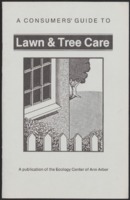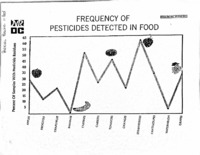Anti-Pesticides Advocacy Continues
With the establishment of the Pesticide Task Force in the 1980s, the EC had begun its advocacy addressing the negative environmental effects of pesticide use. In its first decade, the task force's goal was developing strategies and educational materials for management and use of chemical pesticides. During the 1990s, the EC continued educational outreach by distributing flyers advising concerned individuals about alternatives to toxic pesticides. Topics covered a wide range of issues from lawn care to ways of eliminating pet fleas. In addition to educating a broader public about non-toxic alternatives to pesticides, the EC also fought for legislation establishing the right of consumers to know what chemicals were included in everyday cleaning agents and pesticides.
Miller Manor and Baker Commons
In August 1990, the Ecology Center’s Mike Garfield received word about an Ann Arbor public housing facility, Miller Manor, where seniors were struggling with health issues as a possible result of pesticide application. Jane Booth, a resident of the senior apartments, was experiencing allergic reactions as a result of continual pesticide spraying. Residents were told to leave the facility for an hour after the treatment and that everything would be fine. Instead, many seniors recalled returning to their rooms and seeing a cloud of blue. At first, health defects went unnoticed because residents were older and often had complicating health issues. Booth, however, refused to take no as an answer. Instead, she contacted the Health Department and Jane Borda, who brought Mike Garfield into the conversation.
Subsequent spraying in Baker Commons, another Ann Arbor senior public housing property, was put on hold as the EC, residents, city officials, and community leaders considered alternative pest management programs. Mike Garfield and EC staff contacted with multiple pest control companies and developed an integrated pest management (IPM) program for the facilities. Instead of relying on the regular application of toxic pesticides, IPM involves inspection, monitoring, and establishment of a minimum threshold before applying a treatment option. After the implementation of IPM and consequent reduction in the frequency of pesticide applications, residents of Miller Manor and Baker Commons had improved health outcomes.
Pesticide Legislation
The events at Miller Manor highlighted a need for stricter pesticide regulations. In 1988, Michigan Governor James Blanchard signed amendments to the P.A.171 State Pesticide Control Act. This legislation, which the EC helped implement, upgraded training and certification standards for commercial pesticide applicators and mandated stricter requirements for mixing and loading. Additionally, amendments required that applicators notify chemically-sensitive persons of nearby spraying, stipulated that IPM be used in public buildings, and required applicators to provide contracts, disclosure statements, and risk/benefit info to consumers.
The Ann Arbor Pesticide Ordinance of March 3, 1992 built on state-level legislation to further reduce human exposure to pesticides and the burden of pesticides on the environment. This local legislation encouraged the use of IPM while also enhancing consumer protection by providing the appropriate amount of information on the toxics they could be exposed to.
Later in the 1990s, the EC fought for Regulation #637 which set new standards for pesticide use and protection for sensitive populations by requiring notification before and after a pesticide application. It also addressed previously ignored issues such as off-target pesticide use and set standards for pesticide use in and around schools. One suggested revision to the amendment was proposed by the EC’s own Mike Garfield who advised that consumers should also be informed about pesticide application in indoor areas. The regulation proved controversial because required a agreement between industry and environmentalists to be approved by the Joint Committee on Administrative Rules. After a series of revisions and budget complications, the regulation was finally revised in 1992, a notable victory for the EC’s pesticide-control efforts.




